Bulgaria is a country with very ancient culture that went through many metamorphosis during the centuries. On its lands were found some of the earliest and most interesting and significant findings in Europe and in the whole world, although many of them were stolen, sold abroad, and many of them are still not at all researched. One of the most famous Bulgaria's treasure from Ancient Thrace was found in 1949 by three brothers digging for clay close to Panaguyrishte town. They thought at first that the objects were some gypsy musical instruments, brought them to the mayor and the treasure was exposed in a towel factory in the town for several weeks, then sent in a backpack to a museum in Plovdiv and since then it was featured in hundreds of exhibitions around the world
It consists of a phiale, an amphora and seven rhytons from with a total weight of 6,164 kg of 24 karat gold. It is dated to the IV-III centuries BC, and is thought to have been used as a royal ceremonial set by the Thracian king Seuthes III
The treasure
1.Rhyton in the shape of stag's head with scenes representing labors of Heracles and Theseus
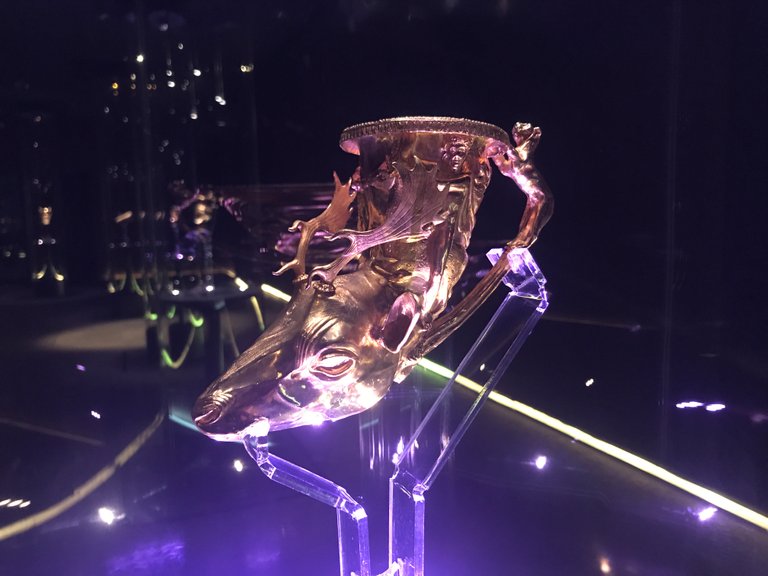
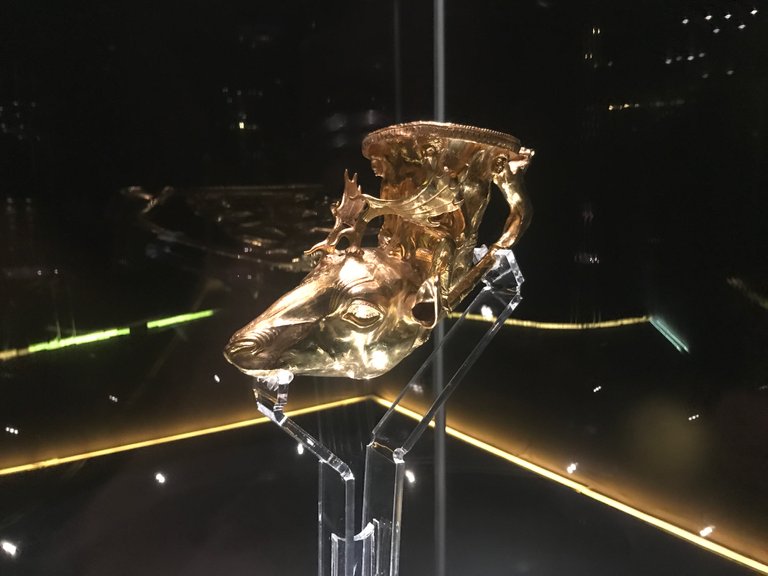
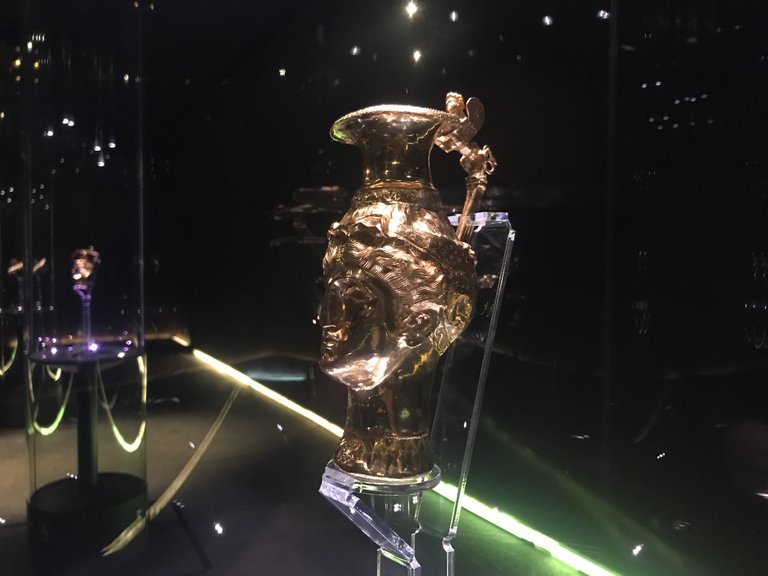
The elements of the treasure are incredibly richly and artistically decorated with scenes of Thracian beliefs, costumes and life. The rhytons were used as ritual cups for sacrificing wine. Wine was poured into the topof the rhyton and poured out of a tiny hole in the bottom into a phiale from where it could be consumed.
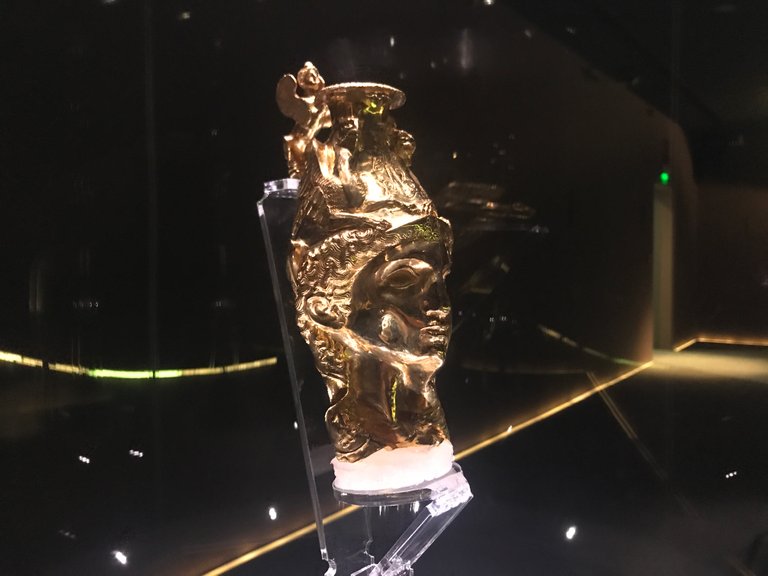
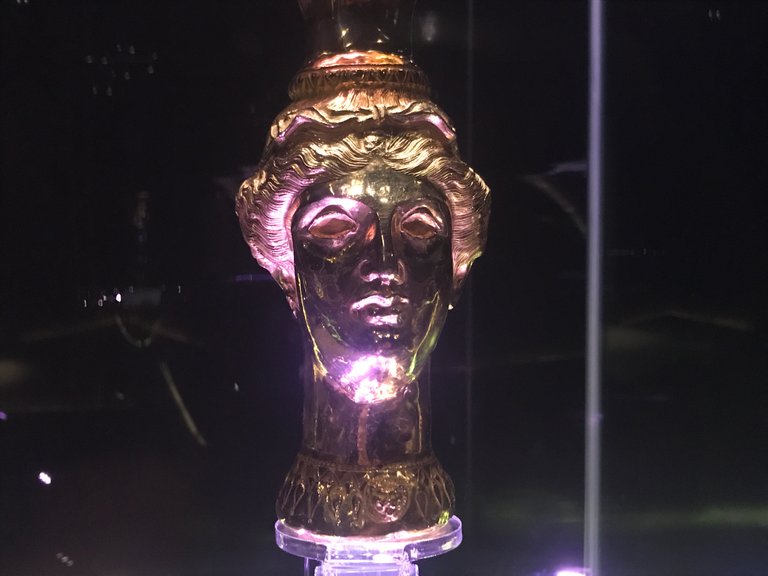
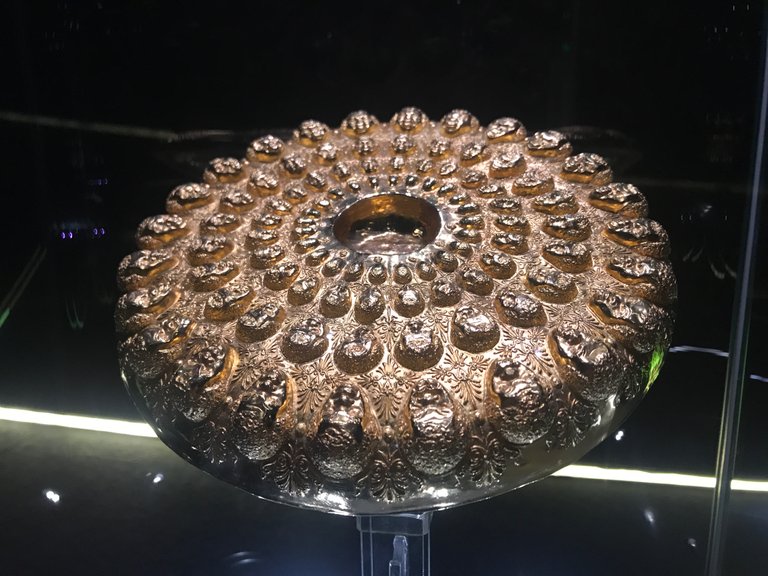
The phiale, a shallow drinking bowl with a hemispherical divot in the middle, was the vessel that was actually brought to the drinker’s lips. The single phiale in the set is about 25 cm in diameter, and its bottom symbolizes the sun, ringed with 24 acorns (matching the crown of Seuthes III which consisted of acorns and oak leaves), and three concentric rings of 24 Ethiopian heads each used to ward off evil.
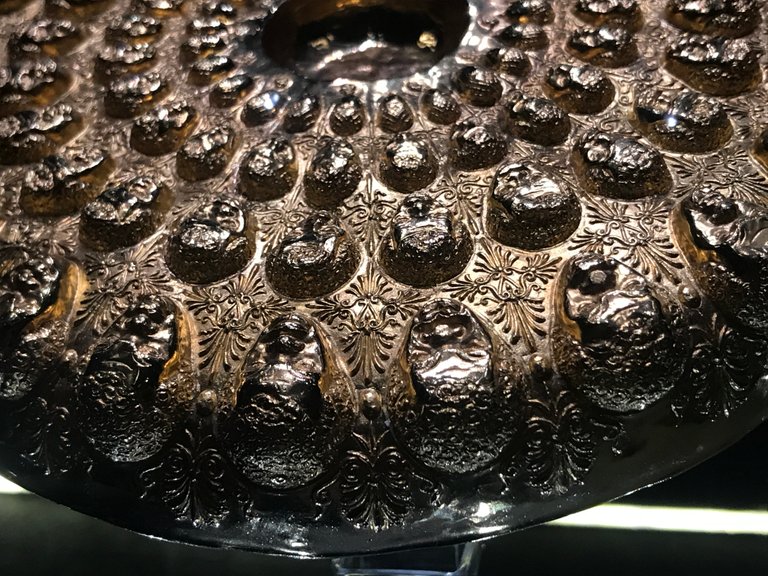
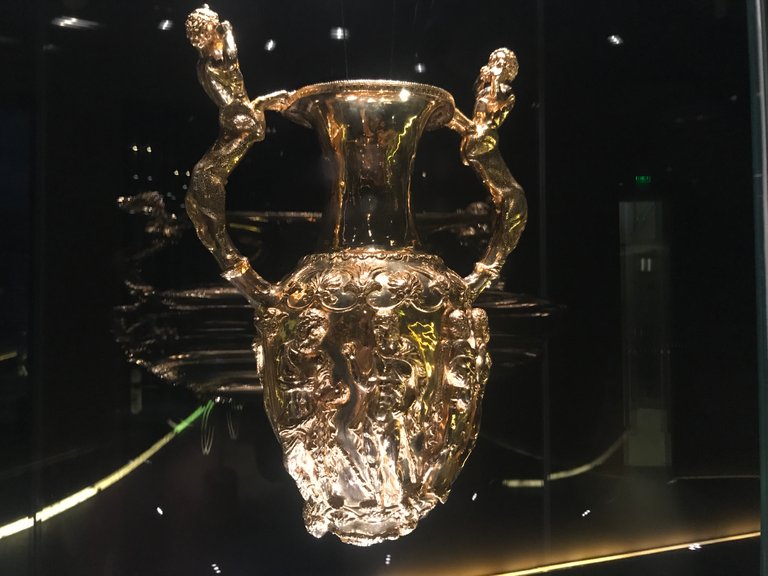
The amphora is the most fascinating vessel in the set, also the heaviest. Depicting seven warriors, it was used as a ceremonial vessel of peace. With a single entry point at the top and two libation holes, it was used to simultaneously pour wine into the phiales of two kings as a sign of peace. This had a practical implication as well, as drinking from the same sanctifying vessel eliminated the possibility that one king might poison the other
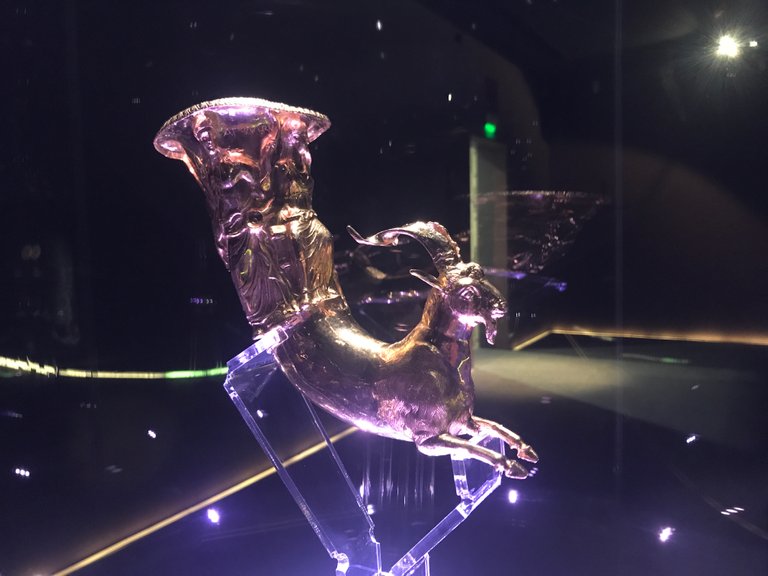
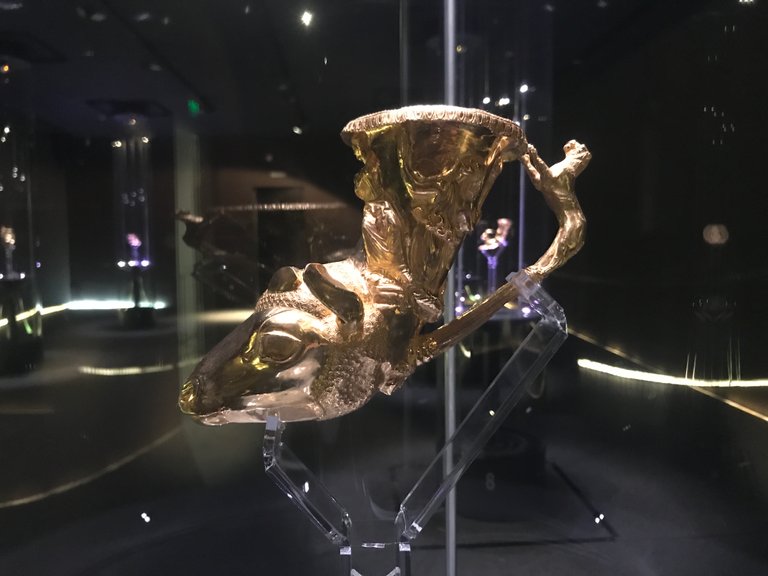
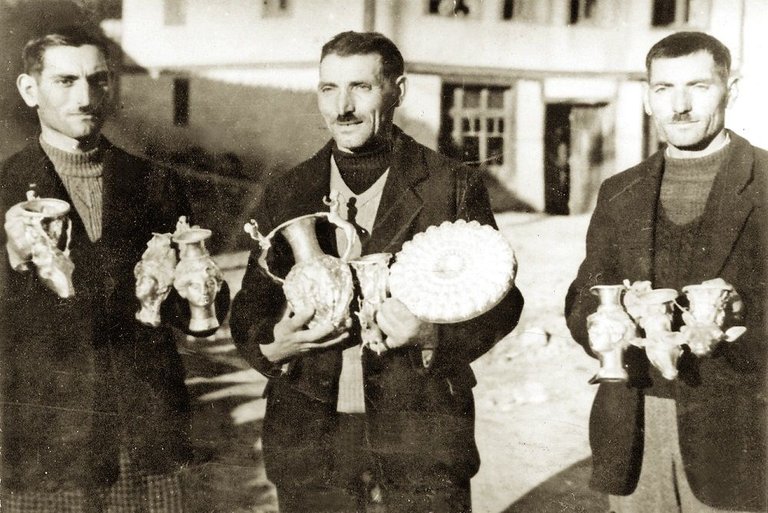

The Museum in Panagyurishte houses the real treasure for around a month every year, otherwise it is in the National history museum in Sofia, and in Panagyurishte there is an non-distinctive from the original treasure replica. There is also one replica for that museum in Sofia, for when it travels around the world and the historical museum in Plovdiv also has one.
Historical Museum Panagyurishte

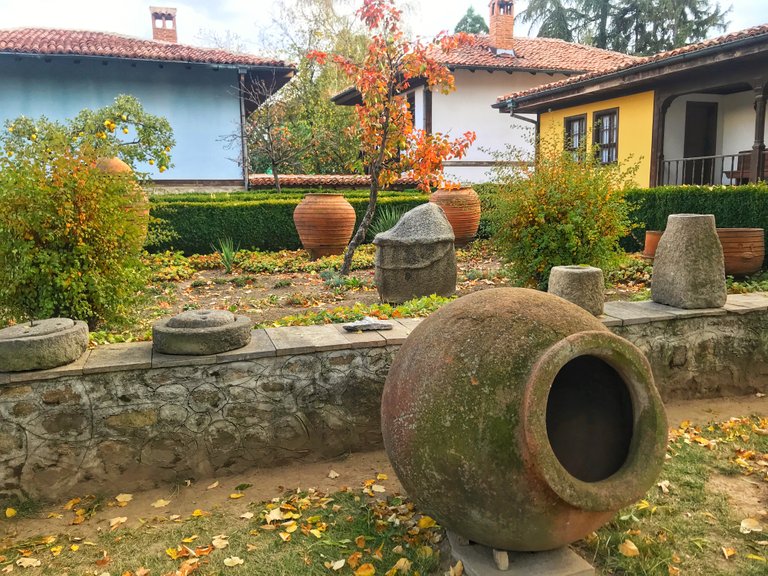

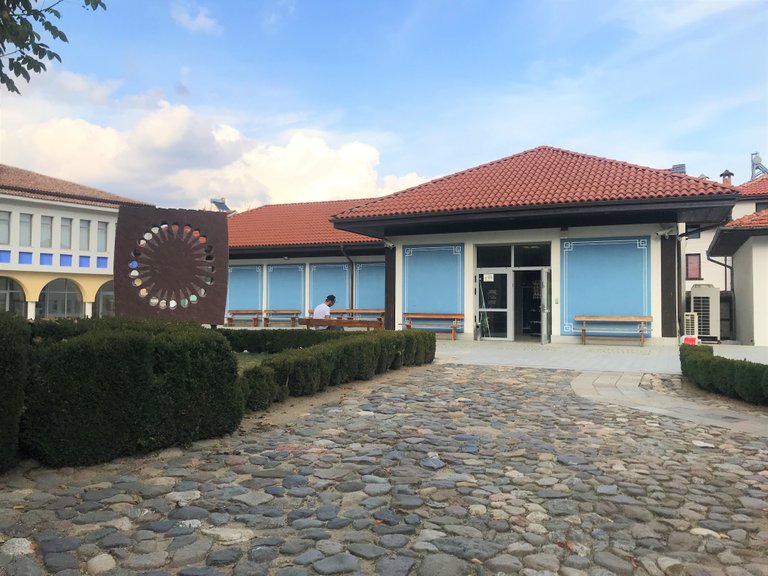


The Ancient Thracians were an ethno-cultural group of Indo-European tribes inhabiting much of Southeast Europe from about the middle of the second millennium BC to about the 6th century AD on the territory of modern-day Bulgaria, Romania, Moldova, Greece, Turkey, Macedonia, Serbia.
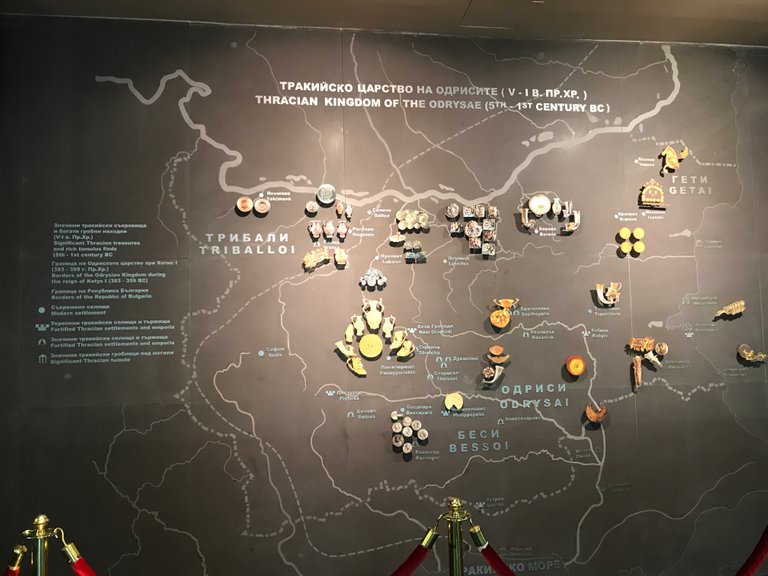
The Odrysian Kingdom was one of the two most powerful states of the Ancient Thracians. The treasure was found on the lands of the Odrysian Kingdom. It existed from the unification of many Thracian tribes by a single ruler, King Teres, in the 5th century BC till its conquest by the Romans in 46 AD on the territory of most of modern-day Bulgaria, Northern Greece, Southeastern Romania, and Northwestern Turkey.
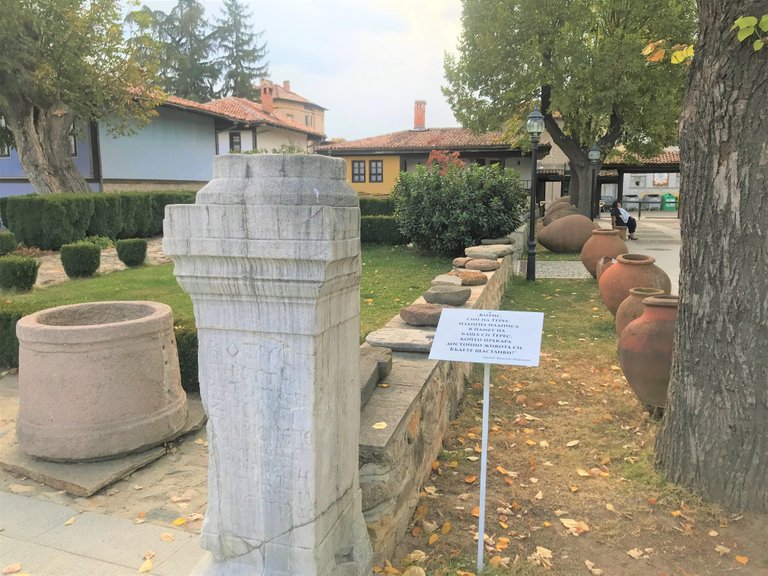
This is an inscription from King Kotis, the son of king Тeres, in memory of his father in the museum.
1.Rhyton in the shape of stag's head with scenes representing labors of Heracles and Theseus



The elements of the treasure are incredibly richly and artistically decorated with scenes of Thracian beliefs, costumes and life. The rhytons were used as ritual cups for sacrificing wine. Wine was poured into the topof the rhyton and poured out of a tiny hole in the bottom into a phiale from where it could be consumed.



The phiale, a shallow drinking bowl with a hemispherical divot in the middle, was the vessel that was actually brought to the drinker’s lips. The single phiale in the set is about 25 cm in diameter, and its bottom symbolizes the sun, ringed with 24 acorns (matching the crown of Seuthes III which consisted of acorns and oak leaves), and three concentric rings of 24 Ethiopian heads each used to ward off evil.


The amphora is the most fascinating vessel in the set, also the heaviest. Depicting seven warriors, it was used as a ceremonial vessel of peace. With a single entry point at the top and two libation holes, it was used to simultaneously pour wine into the phiales of two kings as a sign of peace. This had a practical implication as well, as drinking from the same sanctifying vessel eliminated the possibility that one king might poison the other




The Museum in Panagyurishte houses the real treasure for around a month every year, otherwise it is in the National history museum in Sofia, and in Panagyurishte there is an non-distinctive from the original treasure replica. There is also one replica for that museum in Sofia, for when it travels around the world and the historical museum in Plovdiv also has one.
Historical Museum Panagyurishte






The Ancient Thracians were an ethno-cultural group of Indo-European tribes inhabiting much of Southeast Europe from about the middle of the second millennium BC to about the 6th century AD on the territory of modern-day Bulgaria, Romania, Moldova, Greece, Turkey, Macedonia, Serbia.

The Odrysian Kingdom was one of the two most powerful states of the Ancient Thracians. The treasure was found on the lands of the Odrysian Kingdom. It existed from the unification of many Thracian tribes by a single ruler, King Teres, in the 5th century BC till its conquest by the Romans in 46 AD on the territory of most of modern-day Bulgaria, Northern Greece, Southeastern Romania, and Northwestern Turkey.

This is an inscription from King Kotis, the son of king Тeres, in memory of his father in the museum.



The elements of the treasure are incredibly richly and artistically decorated with scenes of Thracian beliefs, costumes and life. The rhytons were used as ritual cups for sacrificing wine. Wine was poured into the topof the rhyton and poured out of a tiny hole in the bottom into a phiale from where it could be consumed.



The phiale, a shallow drinking bowl with a hemispherical divot in the middle, was the vessel that was actually brought to the drinker’s lips. The single phiale in the set is about 25 cm in diameter, and its bottom symbolizes the sun, ringed with 24 acorns (matching the crown of Seuthes III which consisted of acorns and oak leaves), and three concentric rings of 24 Ethiopian heads each used to ward off evil.


The amphora is the most fascinating vessel in the set, also the heaviest. Depicting seven warriors, it was used as a ceremonial vessel of peace. With a single entry point at the top and two libation holes, it was used to simultaneously pour wine into the phiales of two kings as a sign of peace. This had a practical implication as well, as drinking from the same sanctifying vessel eliminated the possibility that one king might poison the other




The Museum in Panagyurishte houses the real treasure for around a month every year, otherwise it is in the National history museum in Sofia, and in Panagyurishte there is an non-distinctive from the original treasure replica. There is also one replica for that museum in Sofia, for when it travels around the world and the historical museum in Plovdiv also has one.
Historical Museum Panagyurishte






The Ancient Thracians were an ethno-cultural group of Indo-European tribes inhabiting much of Southeast Europe from about the middle of the second millennium BC to about the 6th century AD on the territory of modern-day Bulgaria, Romania, Moldova, Greece, Turkey, Macedonia, Serbia.

The Odrysian Kingdom was one of the two most powerful states of the Ancient Thracians. The treasure was found on the lands of the Odrysian Kingdom. It existed from the unification of many Thracian tribes by a single ruler, King Teres, in the 5th century BC till its conquest by the Romans in 46 AD on the territory of most of modern-day Bulgaria, Northern Greece, Southeastern Romania, and Northwestern Turkey.

This is an inscription from King Kotis, the son of king Тeres, in memory of his father in the museum.
Interesting post @danielapetk. Looking at the vessels, I can see how royal it would feel to pour the wine from them..😀 Great finds and well carved too.
Thanks for sharing. It was something cool to know about.
Thank you very much, @himalayannomad! :) Glad you like it!
What a beautiful collection! It's nice to see the photo of brothers too :) It must have been great for them to learn what kind of discovery they actually did..
Great photos and interesting information, Daniela.
Thank you for sharing! Congratulations on your curie vote! Very well deserved :)
Thank you very much @delishtreats! Great to hear from you :)
This post was shared in the Curation Collective Discord community
community witness. Please consider using one of your witness votes on us here for curators, and upvoted and resteemed by the @c-squared community account after manual review.@c-squared runs a
Thank you very much!
Really really interesting post!! 😃 I love history and mythology so this is right up my Alley.
Posted using Partiko iOS
Thank you very much, @enosh! Glad you like it!
What a great find, thank you for sharing this information, the museum is very interesting and also very beautiful. Happy week, friend.
Thank you very much, @blessed-girl! Great week for you too! :)
Hi danielapetk,
Visit curiesteem.com or join the Curie Discord community to learn more.
Looks like Bulgaria got lucky that day when the three brothers discovered the treasures. Unfortunately there are many hidden treasures everywhere we don't know about. These are real artworks proving that ancient people were real artists even though they didn't have our knowledge and technology.
About the many hidden treasures - the bright side is that some of them are coming out from time to time :) let’s hope for something interesting soon.Hey, @erikah, thanks a lot for your comment. Totally agree with you :) lucky day for Bulgaria!
I believe they(the ancient people) had their own knowledge different than ours, that also served them well :) btw people can’t make an exactly the same replica of the treasure. Even though it is the same, the replica’s weight is half a kilo heavier, thy can’t understand their technique.
Have a great day!
You're right, good thing these treasures are discovered, it's just that in many countries people don't respect anything, they are greedy and these treasures end up in the wrong hands. That is a huge problem.
As about ancient people knowing things, you're right, they were clever and used techniques out engineers can't understand. Look at the pyramids for example.
You to have a good day :)
it's always nice to discover something new. your post looks like a documentary of the ancients with beautiful descriptions and photographs. the finds are really valuable, beautifully decorated and well preserved. Great work and thanks for sharing with ushi @danielapetk
Thank you very much, @road2horizon! Glad you like it! :)
This gets my historian blood pumping! The detail in each of those pieces is amazing, is almost unbelievable that people way back in the 6th century BC did those, but that's where we have to remember that ancient people didn't have the technology but they were smart as fuck, this right here is why museums are so important, preserving our past is a task that must continue on! Thanks for sharing this with all of us!
This post was nominated by a @curie curator to be featured in an upcoming Author Showcase that will be posted in about 12 to 24 hours on the @curie blog.
NOTE: If you would like us to NOT feature your post in the Author Showcase please reply, or DM me on Discord as soon as possible. Any photos or quoted text from your post that we feature will be properly attributed to you as the author.
You can check out our previous Author Showcase to get an idea of what we are doing with these posts.
Thanks for your time and for creating great content.
Franz (@curie curator)
Now this is what I like with art posts in general that talk about the arts of pasts: many fotos (photos) of the item(s) in question, commentary on what it is and where it came from (which can be different from where it was found), the cultural significance of the object and how it has been treated thus far.
On the fotos (photos) side of things: I like how picture-perfect they are. From the crisp and clear details of which there are many to the lively Three-Dimensionality of the objects. Like I can stick my hand through the screen and treat these fotos (photos) as mere windows of time that caught a specific time and place of which we are left to feel the gaze of that time stare at us as we look at it. I especially like the foto (photo) and the timestamping of the antiquity discoverers. People like them putting in the hard effort to find and be able to help demystify the past one item at a time.
The commentary on the items in question: I love how this post can really get descriptive to how simple it can get. Of course with due cause and respect to the complexity of an object. If it was as complex as the items uncovered, then yeah I really loved the explanations of what people were seeing in the museum despite me being able to guess some of it (for which the rest I am thankful for the explanation). And then we get short and quippy statements like the last one with text of the inscription from King Kotis. Would've loved the inscription fotographed (photographed) and then revealing what was actually being stated; and even if it was untranslatable then seeing what was inscribed would be nice to see.
On the cultural significance of the items: I think this post did a great job explaining the culture that surrounded the discovery of these items (especially when they were compared to other objects and dated probably by a carbon test). I really got no quirks nor quips against this post other than maybe how it was formatted when talking about the history of items when put into context of the time. Not complaining it was done bad, just that everything here can be regimentalized and restructured so we can have it so we can talk of history and it being clearly denoted other than key words and a foto (photo) accompanying it.
On how it has been treated so far: I do like how you do discuss the net worth of the items and how they have replicas instead of the real deal on display. Good since art thieves are really a nuisance and can rob a culture of their good culture and what not. Sad we have to but glad we can even make replicas of such, showing very much how perfect we can recreate the past and never lose it even when we lose the originals...
What a find the three brothers had. What astonishes me is not the value of these but the amount of craftsmanship that went into making them. The details are incredible and must have taken years to make.